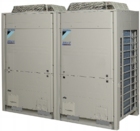Daikin adds optional high sensible mode to VRV air conditioning

Daikin Europe has extended its VRV air-conditioning range with the introduction of optional high-sensible-cooling modes to improve cooling comfort and efficiency in European climates. New 15 Class indoor units launched at the same time are specially designed for climate control in well insulated or small areas such as hotel rooms and offices.
Daikin VRV III incorporates a PID (proportional integral differential) electronic expansion valve that continuously adjusts refrigerant volume to meet the precise demand of the indoor units.
These new high sensible modes increase system efficiency and comfort. In standard high-sensible mode the evaporation temperature is increased, resulting in higher efficiency and comfort due to the high air-discharge temperatures. The system can switch to high-power mode if the cooling load is very high. The evaporation temperature can also be locked to maintain high discharge temperatures at all times, eliminating the risk of cold draughts.
There are two types of 15 Class indoor unit. One is a cassette with a compact casing to fit flush into standard European false ceilings without having to cut ceiling tiles. The other is a slim, concealed ceiling unit that shows only the grilles.








